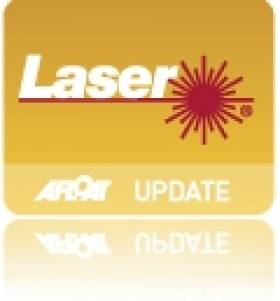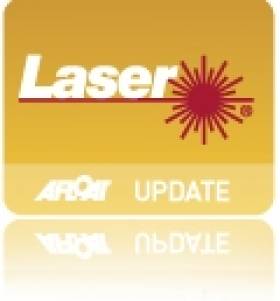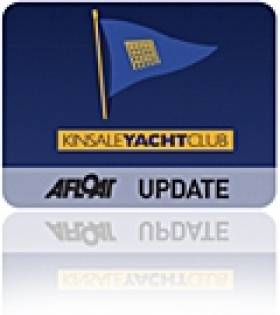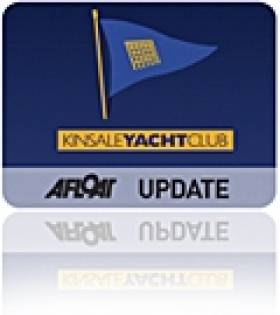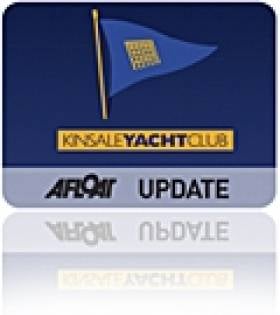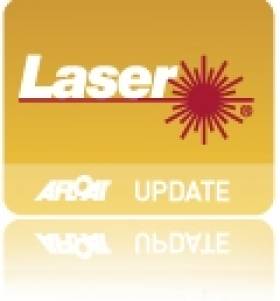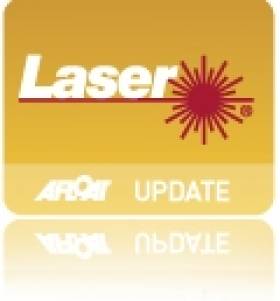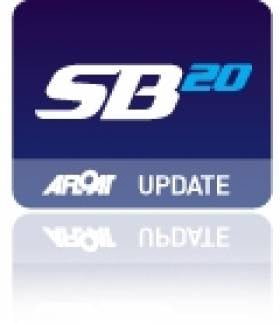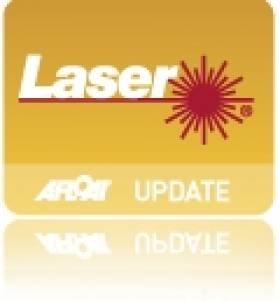Displaying items by tag: Laser
Strangford's Russell Wins Third Laser Europa Cup
#laser – Ireland's Chris Russell has won the third Laser class Europa Cup of the season in thick fog on Lake Lugano, Switzerland.
The podium for the standard rig division consisted of Russell who with 8 points was the overall winner, Cyrill Knecht (SUI), on 10 points, came in second and third place went to Dominykas Kneizys (LTU).
Based out of Strangford Lough, Northern Ireland, Russell is a past Optimist, 420, Laser Radial, and later 470 class sailor.
In a beautiful setting and light winds, Laser sailors from 13 nations competed in the Swiss leg of the 2013 Laser Europa Cup and Euromasters Series.
A total of five races were sailed with one discard. In the 4.7 fleet Tim Leuenberg (GER), on 16 points won, followed by Paolo Mavricic (CRO) on 23 points and Alexander Ebert (GER) on 26 points in third place. The first girl in the 4.7 fleet was Francesca Bergamo (ITA) who finished with 26 points in fourth place.
Laura Cosentino (ITA) reigned in the Laser Radial fleet ahead of Maximilian Kuester (ITA) and Jon Emmet (GBR).
In the Standard rig for the Masterseries, Martin Klawon (GER) won with Mauro Lentini (SUI) and Enrico Negri (ITA) completing the podium.
The Euromaster Radial title went to Jon Emmet (GBR) followed by Mauro Lentini (SUI) and Enrico Negri (ITA).
Results here.
Irish One-Two In Men's Laser Radial At Lake Garda
#Laser - Fionn Lyden and Robbie Gilmore made it a strong one-two finish for Ireland in the men's Laser Radial at the Europa Cup Italy regatta on Lake Garda at the weekend.
September's sailor of the month Lyden is certainly starting the year in impressive style following his runaway victory at the Junior All-Ireland Nationals in his home port of Schull - though Gilmore of Strangford Lough was hot on his heels.
Meanwhile, fourth-placed finisher Finn Lynch of the National Yacht Club - who took the title in 2011 - was just pipped to third position by Poland's Marcin Rudawski.
Further down the field were Royal Cork Yacht Club's Seafra Guilfoyle (8th) and Cian Byrne (18th), and Kinsale Yacht Club's Darragh O'Sullivan (15th) and Ross O'Sullivan (58th).
Elsewhere in the standings at the EurILCA regatta, Howth Yacht Club's Aoife Hopkins finished an impressive sixth in the Laser 4.7 for the women's best result of the four days of sailing at Malcesine.
Hopkins' achievement came with strong showings by Kinsale's Cliodhna O'Regan (14th in the 4.7) and Conor O'Beirne of the Royal St George YC (19th in the men's 4.7).
Also placing in the women's 4.7 were Baltimore's Florence Lyden (33rd) and Royal Cork's Eva Donworth (52nd).
The women's Laser Radial saw placings by Kinsale's Sorcha Ni Shuilleabhain (48th), Ausling Keller of Lough Derg YC (59th) and Chloe Eggers of the Royal St George (85th).
In the men's 4.7, Conor O'Farrell of Carlingford Lough placed 49th while Jack Higgins of the Royal St George was 107th.
In the Standard class, Colin Leonard of Ballyholme Yacht Club finished 37th while Alan Ruigrok of Rush Sailing Club was 48th.
And completing the Irish results in the men's Laser Radial were the Royal Cork's Patrick Crosbie (61st), Dermot Lyden (100th) and Mark Bolger (109th); Kinsale's Dara O'Shea (62nd) and Andrew Levie (126th); Tralee Bay's Tadhg O Loingsigh (75th); Dougie Power of Waterford Harbour Sailing Club (98th); and the Royal St George's Nathaniel Gillet (136th) and Conor Foley (155th).
The complete rankings from the Europa Cup Italy regatta are available HERE.
Laser Sharp Kenneally Wins Kinsale Yacht Club Frostbite Sailing Prize
#kinsale – Ronan Kenneally received the Laser Standard Trophy, Darragh O'Sullivan – the inaugural ASM Radial Trophy, Richard Thompson – the 4.7 Destiny Trophy and Colm Dunne – the Squib Trophy after the final race day of the ASM-Marine KYC Frostbite League.
The early calm conditions on the final day of the ASM-Marine Frostbite League at Kinsale Yacht Club last Sunday morning did not look promising. With two previous race days cancelled due to an excess of wind it was more in hope than expectation that the Race Committee lead by OD Bruce Mathews decided to take to the race area. Their positive action was soon rewarded as the predicted South-Easterly Force 2 to 3 arrived ensuring a timely start to the final day's programme.
With a top mark laid in close proximity to Kinsale boatyard, and the incoming tide early in its cycle, a windward-leeward course was offered to the four competing classes. As racing progressed, with the South-Easterly variable and backing at times thirty to forty degrees and the flood tide increasingly more affective, the usual critical decision of which side of the beat to favour was complicated by the opposing set of conditions.
Consistency was the foundation once again this year for Ronan Kenneally (MBSC) as the returning Champion retained the Laser Standard title. Never out of the top two in any race and scoring seven wins in total, Ronan's final flourish of a second and two firsts placed him in an unassailable lead at the top of this class. Finishing in second and third overall were Matthias Hellstern (KYC) and James Long (Inniscarra SC) with two seconds and a third and two thirds and a second respectively.
Already clear ahead at the top of the Radial Fleet, an off-form Darragh O'Sullivan still retained his overall title from last year, despite just two fifth places on Sunday. Successful on the day were Ewan O'Keeffe (CSC) who won the first race with Dermot Lyden (BSC/RCYC) and Aisling Keller (LDYC/KYC) sharing the next two races, each scoring a win and a second.
Having led the Laser 4.7 League throughout, Richard Thompson (RCYC/KYC) with a fifth and a third still managed to repel a late challenge from Cliodhna O'Regan (KYC) who took line honours in the last two races of the day. Unable to discard a 'maximum points' scoring, Cliodhna had to settle for second overall. Florence Lyden (BSC) had her best day to date with two seconds.
The conclusion to the 2013 Squib Class League had all the promise of a closely fought contest for the top spot, between two very well matched boats. Neither of the two crews directly involved, nor the few privileged to view the contest could have envisaged the enfolding drama. Colm Dunne and Rob Gill in Allegro (KYC), started the first race holding an advantage overall of just a single point, to Marcus & Meagan Hutchinson in Sensation (KYC). Allegro lost that one point advantage in the first race, only to regain it emphatically in the second, thus ensuring the outcome of the final race would determine the winner. With the overall points scoring always subject to the two discards rule, both crews must have been frantically doing the 'Math' at that stage. Concerned only with the relative position of their immediate opponents and with both crews sailing tactically, Allegro quickly established a winning lead only to surrender this at a top-mark 'port and starboard' incident. Accepting the required penalty, they still managed to collect a fourth place to Sensation's second. However, with Allegro's fourth in this race and Sensation's fifth in the second going to discard, Colm Dunne & Rob Gill emerged as worthy Champions by virtue of that single point. On this occasion, Marcus & Meagan Hutchinson had to settle for second place, while Paul McCarthy & Paul Cotter held onto third place also with an excellent first and a second.
Prize-Giving was hosted by Commodore Cameron Good, who on behalf of Kinsale Yacht Club congratulated the deserving winners and thanked all the sailors for their efforts. Special mention went to PRO Bruce Mathews for his continuing and enthusiastic support for this event. Appreciation was additionally expressed for the support of the various Committee members, the Sponsor and the many helpers who had assisted, both on and off the water, to make this annual and long-standing event such an enjoyable regatta. The Commodore awarded the prizes for each class which were presented by Agnes McLaverty on behalf of ASM-Marine. Ronan Kenneally received the Laser Standard Trophy, Darragh O'Sullivan – the inaugural ASM Radial Trophy, Richard Thompson – the 4.7 Destiny Trophy and Colm Dunne – the Squib Trophy.
Kinsale Laser Sailors Brave Strong Winds for a Sunday 'Burn'
#kinsale – With Kinsale Yacht Club racing cancelled due to a building forecast on Sunday local helmsman Rob Howe and one other Laser sailor went out for a 'burn' with the above resulting 'deck-cam' video from Brian Carlin.
Laser Sharp O'Shea Sets Early Mark in Kinsale Frostbites
#kinsale – The seasonal sharp drop in temperature heralded the opening day of the 2013 ASM-Marine Frostbite League at Kinsale Yacht Club on Sunday. The long established winter league, offering early competitive racing opens the KYC sailing season and continues to appeal in the main to the local Laser and Squib Fleets on the South coast. Though entries to the Mixed Dinghy fleet were predictably down in numbers this year, appetites for an injection of excitement were somewhat sated by the appearance of a Rondar built K6.
A chill though steady Force 4 Easterly was the dominating feature of the first day's racing that saw two races completed. The windward-leeward course set by OD's Bruce Mathews and Clem McElligot placed the upwind mark just shy of Kinsale Boatyard crossing the ebbing tide at the start of its cycle.
The three Laser Classes comprising Standard, Radial and 4.7 had a combined start and were first off at the usual time at 12.00 hours. Setting the early pace in the Standard Fleet was RCYC's Edward Rice who expected to take the lead overall with two on-course results of a first and second. Due to missing a mark of the course in error, he settled for an RAF scoring –retirement from the first race. Taking the advantage, KYC's Sean Murphy with a third in race 1 ended the day with a fine win in race 2 and leads the field overall on four points. Eoin Keller (LDYC & KYC) with a consistent showing of a second and third is one point adrift in second position overall. James Long (Inniscarra SC) despite taking line honours in race 1, had to settle for third overall due to a fifth in final race.
KYC's Dara O'Shea has set an early marker in this year's Laser Radial league with his initial results of a second and first, putting him in the top spot on three points. Just two points off the lead is Dermot Lyden (RCYC & BSC) with a win in the first race and a fourth in Race 2. Two points off this mark is Ross O'Sullivan (KYC) due to a fourth and a third.
It is encouraging each year to see the progression of young sailors through the different ranks of the Laser Fleet, and in particular to welcome the new entrants coming into the 4.7 class and gaining their first experience of frostbite series. After the first day of racing Richard Thompson (KYC & RCYC) tops indisputably the league table with two excellent wins. Thomas McGrath's (RCYC) second in the first race against Scott O'Sullivan's (KYC) third being the difference in the battle for second overall.
KYC's familiar stable of Squib crews gathered once again for their annual contest in the Frostbite League with Glandore's Diarmuid Wrenne & Finbar Durgan in Scooby Doo hoping to shake up the local fleet. With last year's winners James and Bruce Mathews participating in Laser this time around – James to the Standard and Bruce to the 4.7 – the way is clear for a compelling and hopefully close-fought competition. Off to a flying start on the first day were Marcus & Meagan Hutchinson in Sensation by winning the league's first two races. Determined to put pressure on the leaders in the weeks ahead are the crews of Colm Dunne & Mark Buckley of Allegro and Victor Fusco & Ruth Ennis of Espresso (is that a double?). With both crews scoring a second and a third they hold the next two positions on the league table on equal points.
Sole entrant to date in the Mixed Dinghy Class was the Peadar Murphy owned K6 - The Widowmaker, crewed on its maiden race by fellow adrenalin junkies Alan Bateman & Keith O'Riordan (KYC). Spectacular performance on the run as the boat leap onto a plane ably assisted by the increasing Force 4 and manfully handled by the crew before succumbing to a spreader bolt giving up the ghost. Looking forward to next week lads?
The league continues over the next five Sundays and is an Open Event for all Lasers, Squibs and Mixed Dinghies. F.G. @ 11.55.
#laser – The Irish Laser Nationals are heading for Crosshaven in 2013 and Cork reader Paul Tingle has been in touch to remind us there will be a celebration of a 30–year anniversary there when the class sails again, a 92-boat fleet having sailed for honours off Cork Harbour in 1983.
In that event a young Mark Lyttle, Ireland's first Olympic representative in the Laser class in 1996, finished sixth in an event won by F. Douglas.
The Tingle family scrap book has revealed a computer print-out (possibly dot-matrix type) of the results from that event with many notable names present. You can download the file below as a PDF document and a quck read is a welcome blast from the past!
Paul's brother Ed was event chairman and the late George Bushe was the OOD.
Laser Sailing Across the Irish Sea Video
UK Laser sailors Steve Cockerill and David Summerville embarked on a challenge of a lifetime last May when as they sailed Laser dinghies across the Irish Sea from from Howth (Ireland) to Holyhead (Wales) to raise funds for Mind and the John Merricks Sailing Trust. The total time involved was 13 Hours 37 Minutes, a distance of 115 nautical miles as this latest video reveals.
Burke Takes Reins of SB20 Class, 2013 Fixtures Published
As out going Chairman of SB20 Ireland it gives me great pleasure to be handing over to the very experienced Justin Burke.
Being part of an emerging class was a very exciting prospect when I took over three years ago.
The SB20 class has had a number of challenges, changing its name from SB3 to Sb20. A new regime of Sportsboat World has recently taken over the franchise.
One of the main reasons for the success of the SB20 has being the number high quality sailors who compete in the class.
The class has maintained very strong numbers and there is very good value to be had in the second hand market.
With a very strong Dublin Bay fleet of 28 boats and good numbers Nationwide bringing the total to in excess of 60 boats, second largest fleet after the UK. The strength of the fleet has being enhanced by having an exciting calendar year on year, point in case is 2013 with Galway hosting the Nationals for the first time.
A real testament to racing around Ireland is the very warm welcome the fleet receives from all the host clubs, and especially its members who volunteer their time to ensure we the competitors have the superb time on the water.
Having the Worlds in 2008 hosted by the National YC with over 140 boats, the class has fleets in Australia, Belgium,Germany,France,Italy, Portugal, Russia, Singapore, Holland & the UK.
This years worlds are this December in Hamilton Island Australia.
In 2013 the Worlds return to Europe and will be held in September in Hyeres in the South of France. This promises to be very well attended regatta as many boats will make a family holiday out of the trip.
As the season ends and we pack our boats away for the winter, we can contemplate a wonderful season ahead in 2013, see below.
Jerry Dowling
Chairman SB20 Ireland ( outgoing)
Calendar 2013
Spring Warmer HYC - April 6/13/20
Followed by the Easterns
Easterns Howth Y.C. - April 27/28th
Westerns L.Ree - May 11/12th (or18/19)
Southerns (Kinsale) - June 08/09th
DunLaoghaire week - July 11/14th
Nationals Galway - July 26/28th
Northerns - Aug 10/11th
Carrickfergus or Royal Ulster
Worlds France - Sept.7th – 13 th
Midlands L.Derg - Oct 19/20th
Irish Laser Sailors Earn International Success as Home Fleet Grows
#lasersailing – With news that Finn Lynch has added a European youth title to his ISAF Youth Silver medal Irish Laser sailing is on a high with international results coming at Olympic and youth level and for the domestic scene it looks like Howth's venerable winter league is returning to some sizeable fleet numbers as the Laser emerges as the ideal recession beating boat.
Lynch is the current U17 European Champion in the Laser Radial following a great regatta in Nieuwpoort, Belgium. It ends a fantastic season for the National Yacht Club sailor.
The superb result was followed when clubmate Philip Doran won the Europa Cup Regatta U19 category on Lake Balaton in Hungary earlier in September. Doran was second overall in the international event finishing on equal points with the winner.
Howth Laser Frostbite
Among a number of top dinghy sailors are moving to the Laser dinghy next month for the Howth Yacht Club's Laser Frostbites starting on November 4th.
The low maintenance single hander is proving to be a great recession boat and making a comeback at club level on both sides of Dublin Bay with DBSC's own handicap fleet dominated by the Olympic boat.
Up to 50 Lasers are expected for the frostbite series at Howth in a few weeks time. There's a handy format of two short races each Sunday with a first gun at 10:45 am.
There's a wide range of standards entering from high ranked national level sailors to beginners. The club is reporting strong interest to the extent
it may yet end up at 1990 levels where the long running series attracted up to 80, making it the biggest laser club racing series in the world at the time.
Laser Radial Programme
With an emphasis on preparation for overseas competition a Munster and Leinster Laser Radial Academy squad has been announced along with training dates for Autumn 2012 starting this weekend. The full squads named are below.
MUNSTER
Mark Hassett
Darragh O'Sullivan
Daire Cournane
Dara O'Shea
Tadhg O'Loingsigh
Darragh McCormack
Sorcha Ni Shuilleabhain
Darragh O'Sullivan
Conor Murphy
Dermot Lyden
Aisling Keller
Ross O'Sullivan
LEINSTER
Dan O'Beirne
Rory McStay
Kevin Harrington
Cian Cahill
Patrick Cahill
Luke Murphy
Aoife Hopkins
Stephen Craig
Frank Devlin
Ronan Jones
Dun Laoghaire Laser Sailors Head for the Mountains and the Sea
#sailing/cycle – Dun Laoghaire's Royal St George Yacht Club is hosting a cycling/sailing event that features a 70km cycle plus three Laser races on Sunday. The novel races takes full advatantage of Dun Laoghaire's unique location between the mountains and the sea. Entries close tomorrow and you can download a poster for the event below as a pdf.
Sailing and cycling are proving popular combination sports appealing to a wide range of sailors, even our London Olympians.
Well known sailing names such as Sean Craig and Colin Galavin have turned their hand to sailing Lasers these days and have been training for the event.
Other class stalwarts Chris Arrowsmith and Theo Lyttle have been seen far from the sea in the Wicklow mountains on their bikes. Paul Keane will be challenging hard for the title after his week training in the south of France.
Earlier this month Olympians Annalise Murphy and Scott Flanigan returned to competition as they competed in a sprint distance triathlon - 750m swim, 20K bike, 5K run, held in Collinstown, Co. Westmeath. They both gave a good account of themselves, results here.
The two day Laser Masters Sail/Cycle Challenge takes places on Saturday 6th and Sunday 7th October 2012. Details below.
Day 1, Cycle, Saturday 6th October
Start: 13:00 sharp from the Club forecourt.
http://www.mapmyride.com/routes/view/51168846
Route: The event will feature a cycle of about 70km, starting at 13:00 on Sat 6th October from the Club. The cycle will finish back at the Club at about 17:00. Have a look at the route on the link for full details.
We invite everyone to come along. You may participate in the cycle or the Laser racing alone, but as the weekend is all about the social we would encourage everyone to jump on a bike and do a few km. The cycle route will take us up to Enniskerry in the Wicklow mountains, so the roads are quiet and the scenery great. This year the challenge has been increased, with the route taking us to the summit of Kippure. It is a tarmac road to the top, but it is steeeep! Total altitude for the cycle is 996m.
There are good places to stop for coffee (or other drink) in Enniskerry and Glencree.
Scoring:
Kippure Summit 1 point
Sally Gap 3 points
Glencree 5 points
Enniskerry 7 points
DNC 10 points
Back to the Club to watch the Leinster Vs Munster Rugby match at 18:30.
Dinner
There is a 3 course dinner in the Club room at 20:00, with a few prizes for the cycling afterwards. The dinner is 25 euro per person. Book early as the dinner was popular last year and the Club room is limited to about 40 people.
Day 2, Sail, Sunday 7th October
On Sunday there will be 3 Laser races starting at 11:00. The races will be short (about 30 minutes), with the emphasis on skill rather than endurance!
The aim is to finish at about 14:00 with prize giving. If 3 races are sailed there will be 1 discard, with your two best races and the cycle score to count.
The entry fee for the sailing/cycling is 15 euro, and for the cycling alone is 5 euro.
Enter online at www.rsgyc.ie


























